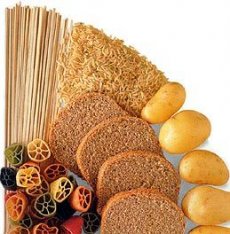Medical expert of the article
New publications
The role of carbohydrates in sports nutrition
Last reviewed: 04.07.2025

All iLive content is medically reviewed or fact checked to ensure as much factual accuracy as possible.
We have strict sourcing guidelines and only link to reputable media sites, academic research institutions and, whenever possible, medically peer reviewed studies. Note that the numbers in parentheses ([1], [2], etc.) are clickable links to these studies.
If you feel that any of our content is inaccurate, out-of-date, or otherwise questionable, please select it and press Ctrl + Enter.

High-carbohydrate foods are classified by the type of carbohydrate (simple or complex), the form of carbohydrate (liquid or solid), or the glycemic index of the carbohydrate (low, medium, high). Classifying carbohydrates as simple or complex, liquid or solid does not reflect the effect of carbohydrate-rich foods and liquids on blood glucose and insulin levels, but classifying them by glycemic index does.
The glycemic index is used to classify different foods by measuring the blood glucose level after eating them and comparing it to a standard food, either glucose or white bread. The index is calculated by taking the increase in the blood glucose curve after eating a test food that provides 50 g of carbohydrate, compared to the same curve after eating the same amount of carbohydrate from a standard food. All tests are performed on an empty stomach.
Foods are classified as high-glycemic (glucose, bread, potatoes, breakfast cereals, sports drinks), medium-glycemic (sucrose, soft drinks, oats, tropical fruits: bananas and mangoes), or low-glycemic (fructose, milk, yogurt, lentils, cool-climate fruits: apples and oranges). There are published international glycemic index tables for many types of foods.
The glycemic index reflects the ability to digest and absorb carbohydrate-rich foods. It is influenced by the form of food (particle size, presence of whole grains, structure and viscosity), the degree of processing and cooking of food, the presence of fructose or lactose (both have a low glycemic index), the ratio of amylopectin to amylose in starch (the rate of digestion of amylose is low), the interaction of starch with protein or starch with fat, as well as the presence of phytins and lectins.
It is suggested that by manipulating the glycemic indices of various foods and meals, it is possible to increase carbohydrate intake and improve athletic performance. For example, foods with a low glycemic index may be recommended before exercise to maintain carbohydrate levels. Foods rich in carbohydrates with a medium or high glycemic index may be recommended during exercise to ensure carbohydrate oxidation and after exercise to replenish glycogen.
The glycemic index concept has limitations. It is based on the same amount (50 g) of carbohydrates, not on an average. The index values that are available are also mostly based on tests using a single food item, so the blood glucose response to high-glycemic foods may be smoothed out when combined with low-glycemic foods in meals. However, for mixed meals, a weighted average of the glycemic indices of the carbohydrate-rich foods that make up the meal can be applied.
The glycemic index is useful for athletes in making food choices. However, further research is needed. The index should not be used solely to determine carbohydrate and food intake before, during, and after exercise. Foods have other characteristics that are important to athletes, such as nutritional value, taste, portability, cost, tolerability, and ease of preparation. Since food choices are specific to each individual and type of exercise, athletes should choose foods according to their nutritional goals.

